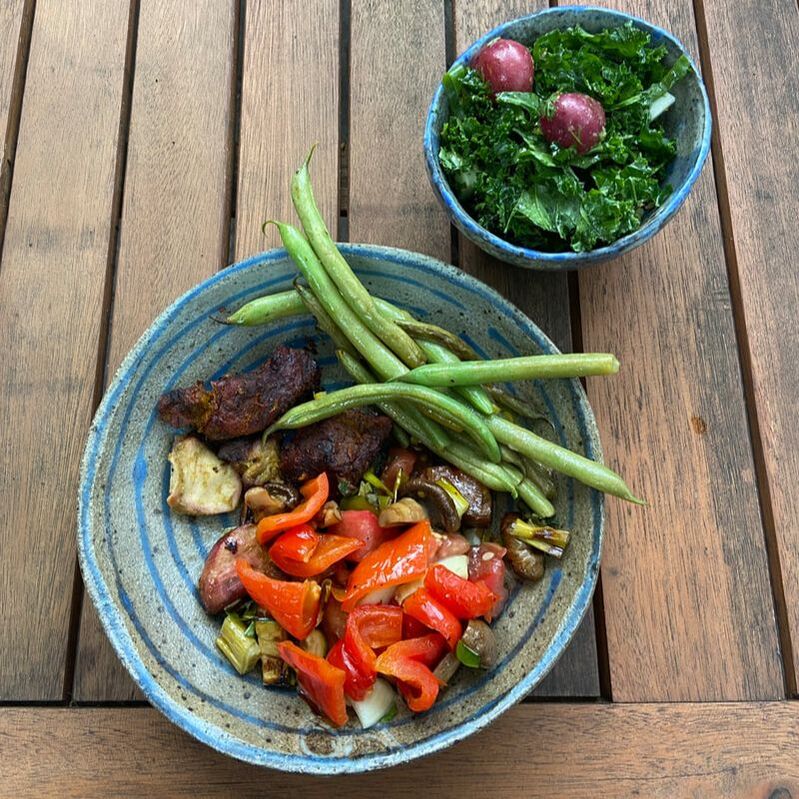|
What we know about nutrition changes every day. This is one of the things that makes being a nutritionist so fun and exciting - there's always something new to learn!
As an eater, who strives to do right by your body, this may also pose a challenge. It's tempting to eat the same thing day after day once you've dialed in what works for you. You find a formula that satisfies your appetite, is balanced, nutritious and doable. Why not rinse and repeat, right? It turns out that variety is not just the spice of life, it also imparts benefits to the body. Why? It's all about color! Phytonutrients are found in all plants. They are the pigments that give plants color, including anthocyanidins (blue, purple, black) and carotenoids (orange, red, yellow). They have potent antioxidant potential, helping to relieve oxidative stress that can lead to inflammation and disease. Interestingly, phytonutrients are also slightly toxic. This is actually beneficial to eaters because they gently guide and train the immune system, making it stronger and more resilient to infections and disease. Interesting stuff! The microbiome of the large intestine plays an intimate role in metabolizing phytonutrients. These chemicals are not broken down efficiently in the upper digestive tract where most nutrients are digested and absorbed. Instead phytonutrients make their way to the colon and are activated by the microorganisms there. Phytonutrients influence the microbes, encouraging a healthy immune response and reducing inflammation. In turn, the microbes transform phytonutrients into phenolic compounds that can be absorbed and used by the host/eater. It is largely accepted as truth that eating vegetables and fruits is an important feature of a healthy diet. Every client I talk to knows that the one thing they can do to improve their diet is to eat more from these food categories. That being the case, Americans tend to struggle with this dietary adaptation. Only 9% of Americans meet the USDA's recommendation of daily vegetable intake and 12% meet that for fruit. Affordable access to fruits and vegetables is a major concern in the wellness sphere. Additionally, preparation and storage of fresh produce is a barrier for many people. These concerns are beyond the scope of this article but worth mentioning as a contributing factor to the low consumption of fruits and vegetables in the US. In my experience and opinion, it's not an issue of educating the public on the health benefits of these foods, but an issue of equity. Insufficient vegetable and fruit intake has a detrimental impact on vitamin and mineral status, but there's more to plant-based foods than that. As researchers further our understanding of the role phytonutrients play in human health, a phytonutrient gap becomes apparent. One recommendation I make often to my nutrition clients is to eat the rainbow in plants every day. Getting in the habit of grabbing a red, orange, yellow, green, blue and purple item from the produce department is a great start to a meal plan that powers disease prevention and wellness. Phytonutrients are present in all plants. In addition to vegetables and fruits, nuts, seeds, grains, legumes, herbs and spices contain these compounds. Getting in the habit of making colorful, flavorful and beautiful food is a way to increase the phytonutrient density of your meals...while also giving your eyes a feast as well! If food preparation and cooking is a barrier for you working this habit into your life schedule, here are a couple tips to make eating the rainbow more manageable:
If you enjoy cooking with a recipe, here are a couple plant-heavy food blogs and cookbooks I recommend for getting inspired and making something delicious to enjoy:
Eating the rainbow can be a really fun self-care strategy that brings pleasure to all your senses and wellness to every system in your body. Bring on the color!
0 Comments
Leave a Reply. |
I love food.I love thinking about it, talking about it, writing about it. I love growing food, cooking and eating food. I use this space to try to convey that. Follow me on social media for more day-to-day inspiration on these topics. Categories
All
|

 RSS Feed
RSS Feed